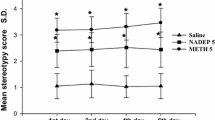Abstract
The methylphenidate antagonistic effect of haloperidol was investigated in normal and haloperidol tolerant mice under the influence of cholinergic and anticholinergic treatment. Physostigmine increased the potency of haloperidol against stereotypies induced by methylphenidate, whereas scopolamine reduced the effect of haloperidol. The effect of haloperidol was influenced both in non-pretreated mice and in haloperidol-pretreated mice. It is concluded, that a cholinergic-dopaminergic balance is of importance for the antagonistic effect of a neuropeptic agent against methylphenidate-induced gnawing-compulsion in normal mice as well as in mice which have become tolerant to neuroleptics.
Similar content being viewed by others
References
Costal, B., Naylor, R. J.: Modification of amphetamine effects by intracerebrally administered anticholinergic agents. Life Sci. 11, 239–253 (1972)
Ernst, A. M.: Mode of action of apomorphine and dexamphetamine in gnawing compulsion in rats. Psychopharmacologia (Berl.) 10, 316–323 (1967)
Finney, D. J.: Probit analysis, 2nd ed., pp. 65–72.: Cambridge University Press 1952
Fjalland, B., MØller Nielsen, I.: Enhancement of methylphenidate-induced stereotypies by repeated administration of neuroleptics. Psychopharmacologia (Berl.) 34, 105–109 (1974)
Fog, R., Pakkenberg, H.: Behavioural effects of dopamine and p-hydroxyamphetamine injected into corpus striatum of rats. Exp. Neurol. 31, 75–86 (1971)
Janowsky, D. S., El-Yousef, M. K., Davis, J. M., Sekerke, H. I.: Cholinergic antagonism of methylphenidate-induced stereotyped behavior. Psychopharmacologia (Berl.) 27, 295–303 (1972)
MØller Nielsen, I., Fjalland, B., Pedersen, V., Nymark, M.: Pharmacology of neuroleptics upon repeated administration. Psychopharmacologia (Berl.) 34, 95–104 (1974)
Pedersen, V.: Potentiation of apomorphine effect (compulsive gnawing behaviour) in mice. Acta pharmacol. (Kbh.) 25, Suppl. 4, 63 (1967)
Pedersen, V., Christensen, A. V.: Antagonism of methylphenidate-induced stereotyped gnawing in mice. Acta pharmacol. (Kbh.) 31, 488–496 (1972)
Pedersen, V., Christensen, A. V.: Methylphenidate antagonism in mice as a rapid screening test for neuroleptic drugs. Acta pharmacol. (Kbh.) 29, Suppl. 4, 44 (1971)
Scheel-Krüger, J.: Central effects of anticholinergic drugs measured by the apomorphine gnawing test in mice. Acta pharmacol. (Kbh.) 28, 1–16 (1970)
Scheel-Krüger, J.: Comparative studies of various amphetamine analogues demonstrating different interactions with the metabolism of the catecholamines in the brain. Europ. J. Pharmacol. 14, 47–59 (1971)
Scheel-Krüger, J., Randrup, A.: Stereotype hyperactive behaviour produced by dopamine in the absence of noradrenaline. Life Sci. 6, 1389–1398 (1967)
Ther, L., Schramm, H.: Apomorphin-synergismus (Zwangsnagen bei MÄusen) als Test zur Differenzierung psychotroper Substanzen. Arch. int. Pharmacodyn. 138, 302–310 (1962)
Van der Waerden, B. L., Nievegelt, E.: Tables for comparing two samples by X-test and sign test. Berlin-Göttingen-Heidelberg: Springer 1956
Author information
Authors and Affiliations
Rights and permissions
About this article
Cite this article
Fjalland, B., Nielsen, I.M. Methylphenidate antagonism of haloperidol, interaction with cholinergic and anticholinergic drugs. Psychopharmacologia 34, 111–118 (1974). https://doi.org/10.1007/BF00421935
Received:
Issue Date:
DOI: https://doi.org/10.1007/BF00421935



